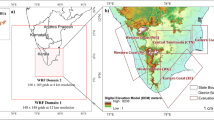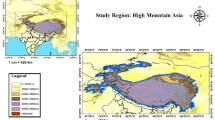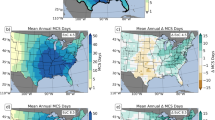Abstract
Climate change is imminent and threatens the largest watershed in the world, the Amazon basin. As general circulation models may fail to represent cloud-scale phenomena, precipitation in a changing climate under global warming is still a factor of great uncertainty, especially in Tropical regions. In this study, we used long-term high-resolution simulations from a global cloud-resolving model under the scope of the Coupled Model Intercomparison Project (CMIP6) to verify the climate change impacts on the mesoscale convective systems (MCSs) over the Amazon basin. We generated a complete spatial, temporal, and statistical characterization of the MCSs for the past (1950–1960), present (2000–2010), and near-future (2040–2050). We found that MCSs are a critical mechanism for precipitation, especially in austral winter. The simulations are consistent with the observed precipitation and MCSs patterns over the Amazon basin, indicating that MCSs are less frequent compared to the past and are expected to continuously decline in the near-future. Most decreases are projected from September to December, while an increase between June to August, mainly in the southern portion of the Amazon basin. In addition, the investigation presented here shows the great potential of using a global cloud-resolving model under the CMIP6 scope to investigate mesoscale systems in a warming climate.







Similar content being viewed by others
Data availability
The datasets generated during and/or analyzed during the current study are not publicly available due to their large volume but are available from the corresponding author upon reasonable request.
References
Ambrizzi T, Reboita MS, da Rocha RP, Llopart M (2019) The state of the art and fundamental aspects of regional climate modeling in South America. Ann N Y Acad Sci 1436:98–120
Anselmo EM, Machado LA, Schumacher C, Kiladis GN (2021) Amazonian mesoscale convective systems: life cycle and propagation characteristics. Int J Climatol 41:3968–3981
Avila-Diaz A, Benezoli V, Justino F, Torres R, Wilson A (2020) Assessing current and future trends of climate extremes across Brazil based on reanalyses and earth system model projections. Clim Dyn 55:1403–1426
Cohen JC, Silva Dias MA, Nobre CA (1995) Environmental conditions associated with Amazonian squall lines: a case study. Mon Weather Rev 123:3163–3174
Davidson EA, de Araújo AC, Artaxo P, Balch JK, Brown IF, Bustamante MM, Coe MT, DeFries RS, Keller M, Longo M, Munger JW (2012) The Amazon basin in transition. Nature 481:321–328
Debortoli NS, Dubreuil V, Funatsu B, Delahaye F, de Oliveira CH, Rodrigues-Filho S, Saito CH, Fetter R (2015) Rainfall patterns in the Southern Amazon: a chronological perspective (1971–2010). Clim Change 132:251–264
Drumond A, Marengo J, Ambrizzi T, Nieto R, Moreira L, Gimeno L (2014) The role of the Amazon Basin moisture in the atmospheric branch of the hydrological cycle: a Lagrangian analysis. Hydrol Earth Syst Sci 18(7):2577–2598
Espinoza JC, Sörensson AA, Ronchail J, Molina-Carpio J, Segura H, Gutierrez-Cori O, Ruscica R, Condom T, Wongchuig-Correa S (2019) Regional hydro-climatic changes in the Southern Amazon Basin (Upper Madeira Basin) during the 1982–2017 period. J Hydrol Reg Stud 26:100637
Eyring V, Bony S, Meehl GA, Senior CA, Stevens B, Stouffer RJ, Taylor KE (2016) Overview of the Coupled Model Intercomparison Project Phase 6 (CMIP6) experimental design and organization. Geosci Model Dev 9(5):1937–1958
Feng Z et al (2016) More frequent intense and long-lived storms dominate the springtime trend in central US rainfall. Nat Commun 7:1–8
Feng Z, Song F, Sakaguchi K, Leung LR (2021) Evaluation of mesoscale convective systems in climate simulations: methodological development and results from MPAS-CAM over the United States. J Clim 34:2611–2633
Garstang M, Massie HL Jr, Halverson J, Greco S, Scala J (1994) Amazon coastal squall lines. Part I: structure and kinematics. Mon Weather Rev 122:608–622
Haarsma RJ, Roberts MJ, Vidale PL, Senior CA, Bellucci A, Bao Q, Chang P, Corti S, Fučkar NS, Guemas V, Hardenberg JV (2016) High resolution model intercomparison project (HighResMIPv.10) for CMIP6. Geosci Model Dev 9:4185–4208
Haghtalab N, Moore N, Heerspink BP, Hyndman DW (2020) Evaluating spatial patterns in precipitation trends across the Amazon basin driven by land cover and global scale forcings. Theor Appl Climatol 140:411–427
Houze RA (2004) Mesoscale convective systems. Rev Geophys 42:RG4003
Houze RA (2018) 100 years of research on mesoscale convective systems. A century of progress in atmospheric and related sciences: celebrating the American Meteorological Society centennial, meteorological monographs, 59. American Meteorological Society, Providence
Huffman GJ, Stocker EF, Bolvin DT, Nelkin EJ, Tan J (2019) GPM IMERG Final Precipitation L3 1 month 0.1 degree × 0.1 degree V06, Greenbelt, MD, Goddard Earth Sciences Data and Information Services Center (GES DISC). Accessed 01 Nov 2021
Inoue T, Satoh M, Miura H, Mapes B (2008) Characteristics of cloud size of deep convection simulated by a global cloud resolving model over the western tropical Pacific. J Meteorol Soc Jpn Ser II 86:1–15
Inoue T, Rajendran K, Satoh M, Miura H (2021) On the semidiurnal variation in surface rainfall rate over the tropics in a global cloud-resolving model simulation and satellite observations. J Meteorol Soc Jpn 99(5):1371–1388
Janowiak JE, Joyce RJ, Yarosh Y (2001) A real-time global half-hourly pixel-resolution infrared dataset and its applications. Bull Am Meteorol Soc 82:205–217
Joyce RJ et al (2004) CMORPH: a method that produces global precipitation estimates from passive microwave and infrared data at high spatial and temporal resolution. J Hydrometeorol 5:487–503
Kodama C, Ohno T, Seiki T, Yashiro H, Noda AT, Nakano M, Yamada Y, Roh W, Satoh M, Nitta T, Goto D (2021) The Nonhydrostatic ICosahedral Atmospheric Model for CMIP6 HighResMIP simulations (NICAM16-S): experimental design, model description, and impacts of model updates. Geosci Model Dev 14:795–820
Kousky VE (1980) Diurnal rainfall variation in northeast Brazil. Mon Weather Rev 108(4):488–498
Laurent H, Machado LA, Morales CA, Durieux L (2002) Characteristics of the Amazonian mesoscale convective systems observed from satellite and radar during the WETAMC/LBA experiment. J Geophys Res Atmos 107:LBA-21
Llopart M, Coppola E, Giorgi F, Da Rocha RP, Cuadra SV (2014) Climate change impact on precipitation for the Amazon and La Plata basins. Clim Change 125(1):111–125
Machado LAT, Rossow WB, Guedes RL, Walker AW (1998) Life cycle variations of mesoscale convective systems over the Americas. Mon Weather Rev 126:1630–1654
Machado LAT, Laurent H, Lima AA (2002) Diurnal march of the convection observed during TRMM-WETAMC/LBA. J Geophys Res Atmos 107(D20):LBA-31
Machado LAT, Laurent H, Dessay N, Miranda I (2004) Seasonal and diurnal variability of convection over the Amazonia: a comparison of different vegetation types and large scale forcing. Theoret Appl Climatol 78(1):61–77
Marengo JA (2009) Long-term trends and cycles in the hydrometeorology of the Amazon basin since the late 1920s. Hydrol Process Int J 23(22):3236–3244
Marengo JA, Espinoza JC (2016) Extreme seasonal droughts and floods in Amazonia: causes, trends and impacts. Int J Climatol 36(3):1033–1050
Marengo JA, Ambrizzi T, Da Rocha RP, Alves LM, Cuadra SV, Valverde MC, Torres RR, Santos DC, Ferraz SE (2010) Future change of climate in South America in the late twenty-first century: intercomparison of scenarios from three regional climate models. Clim Dyn 35(6):1073–1097
Medvigy D, Walko RL, Avissar R (2008) Modeling interannual variability of the Amazon hydroclimate. Geophys Res Lett 35:L15817. https://doi.org/10.1029/2008GL034941
Miyamoto Y, Kajikawa Y, Yoshida R, Yamaura T, Yashiro H, Tomita H (2013) Deep moist atmospheric convection in a subkilometer global simulation. Geophys Res Lett 40(18):4922–4926
Negron-Juárez RI, Chambers JQ, Guimaraes G, Zeng H, Raupp CF, Marra DM, Ribeiro GHPM, Saatchi SS, Nelson B, Higuchi N (2010) Widespread Amazon forest tree mortality from a single cross‐basin squall line event. Geophys Res Lett 37:L16701. https://doi.org/10.1029/2010GL043733
Nobre CA, Sellers PJ, Shukla J (1991) Amazonian deforestation and regional climate change. J Clim 4(10):957–988
Nunes AMP, Silva Dias MA, Anselmo EM, Morales CA (2016) Severe convection features in the Amazon basin: a TRMM-based 15-year evaluation. Front Earth Sci 4:37
O’Neill BC, Tebaldi C, van Vuuren DP, Eyring V, Friedlingstein P, Hurtt G, Knutti R, Kriegler E, Lamarque J-F, Lowe J, Meehl GA, Moss R, Riahi K, Sanderson BM (2016) The Scenario Model Intercomparison Project (ScenarioMIP) for CMIP6. Geosci Model Dev 9:3461–3482
Ohno T, Satoh M, Noda A (2019) Fine vertical resolution radiative-convective equilibrium experiments: roles of turbulent mixing on the high-cloud response to sea surface temperatures. J Adv Model Earth Syst 11:1637–1654
Oliveira R, Maggioni V, Vila D, Morales C (2016) Characteristics and diurnal cycle of GPM rainfall estimates over the central Amazon region. Remote Sens 8(7):544
Pereira Filho AJ, Carbone RE, Tuttle JD, Karam HA (2015) Convective rainfall in Amazonia and adjacent tropics. Atmos Clim Sci 5(02):137
Prein AF, Liu C, Ikeda K, Trier SB, Rasmussen RM, Holland GJ, Clark MP (2017) Increased rainfall volume from future convective storms in the US. Nat Clim Change 7(12):880–884
Reboita MS, da Rocha RP, Dias CG, Ynoue RY (2014) Climate projections for South America: RegCM3 driven by HadCM3 and ECHAM5. Adv Meteorol 2014:376738. https://doi.org/10.1155/2014/376738
Rehbein A, Ambrizzi T, Mechoso CR (2017) Mesoscale convective systems over the Amazon basin. Part I: climatological aspects. Int J Climatol 38:215–229
Rehbein A, Ambrizzi T, Mechoso CR, Ibarra-Espinosa S, Myers TA (2019) Mesoscale convective systems over the Amazon basin: the GoAmazon2014/5 program. Int J Climatol 39:5599–5618
Rehbein A (2021) Mesoscale convective systems in the Amazon basin: present climate and future projections in climate change scenarios. Ph.D. thesis, Instituto de Astronomia, Geofísica e Ciências Atmosféricas, Universidade de São Paulo, São Paulo
Roberts MJ, Vidale PL, Senior C, Hewitt HT, Bates C, Berthou S, Chang P, Christensen HM, Danilov S, Demory ME, Griffies SM (2018) The benefits of global high resolution for climate simulation: process understanding and the enabling of stakeholder decisions at the regional scale. Bull Am Meteorol Soc 99(11):2341–2359
da Rocha RP, Morales CA, Cuadra SV, Ambrizzi T (2009) Precipitation diurnal cycle and summer climatology assessment over South America: an evaluation of regional climate model version 3 simulations. J Geophys Res Atmos 114:D10108. https://doi.org/10.1029/2008JD010212
Sakamoto MS, Ambrizzi T, Poveda G (2011) Moisture sources and life cycle of convective systems over Western Colombia. Adv Meteorol 2011:890759
Salio P, Nicolini M, Zipser EJ (2007) Mesoscale convective systems over southeastern South America and their relationship with the South American low-level jet. Mon Weather Rev 135:1290–1309
Sato T, Miura H, Satoh M, Takayabu YN, Wang Y (2009) Diurnal cycle of precipitation in the tropics simulated in a global cloud-resolving model. J Clim 22(18):4809–4826
Satoh M, Matsuno T, Tomita H, Miura H, Nasuno T, Iga SI (2008) Nonhydrostatic icosahedral atmospheric model (NICAM) for global cloud resolving simulations. J Comput Phys 227(7):3486–3514
Satoh M, Tomita H, Yashiro H, Miura H, Kodama C, Seiki T, Noda AT, Yamada Y, Goto D, Sawada M, Miyoshi T (2014) The non-hydrostatic icosahedral atmospheric model: description and development. Progr Earth Planet Sci 1(1):1–32
Satoh M, Yamada Y, Sugi M, Kodama C, Noda AT (2015) Constraint on future change in global frequency of tropical cyclones due to global warming. J Meteorol Soc Jpn Ser II 93(4):489–500
Satyamurty P, Nobre CA, Dias PLS (1998) South America. In: Karoly DJ, Vincent DG (eds) Meteorology of the southern hemisphere. American Meteorological Society, Boston, pp 119–139
Schneider U, Becker A, Finger P, Meyer-Christoffer A, Rudolf B, Ziese M (2011) GPCC Full Data Reanalysis Version 6.0 at 0.5°: monthly land-surface precipitation from rain-gauges built on GTS-based and historic data. https://doi.org/10.5676/DWD_GPCC/FD_M_V7_050
Schumacher RS, Rasmussen KL (2020) The formation, character and changing nature of mesoscale convective systems. Nat Rev Earth Environ 1(6):300–314
Silva Dias MAF, Ferreira RN (1992) Application of a linear spectral model to the study of Amazonian squall lines during GTE/ABLE 2B. J Geophys Res Atmos 97(D18):20405–20419
Silva Dias MAF, Petersen W, Silva Dias PL, Cifelli R, Betts AK, Longo M, Gomes AM, Fisch GF, Lima MA, Antonio MA, Albrecht RI (2002a) A case study of convective organization into precipitating lines in the Southwest Amazon during the WETAMC and TRMM-LBA. J Geophys Res Atmos 107(D20):LBA-46
Silva Dias MAF, Rutledge S, Kabat P, Silva Dias PL, Nobre C, Fisch G, Dolman AJ, Zipser E, Garstang M, Manzi AO, Fuentes JD (2002b) Cloud and rain processes in a biosphere–atmosphere interaction context in the Amazon region. J Geophys Res Atmos 107(D20):LBA-39
Silva Dias MAF, Silva Dias PL, Longo M, Fitzjarrald DR, Denning AS (2004) River breeze circulation in eastern Amazonia: observations and modelling results. Theoret Appl Climatol 78(1):111–121
Solman SA (2013) Regional climate modeling over South America: a review. Adv Meteorol 2013:504357. https://doi.org/10.1155/2013/504357
Stevens B, Satoh M, Auger L, Biercamp J, Bretherton CS, Chen X, Düben P, Judt F, Khairoutdinov M, Klocke D, Kodama C (2019) DYAMOND: the dynamics of the atmospheric general circulation modeled on non-hydrostatic domains. Prog Earth Planet Sci 6(1):1–17
Taylor CM, Belušić D, Guichard F, Parker DJ, Vischel T, Bock O, Panthou G (2017) Frequency of extreme Sahelian storms tripled since 1982 in satellite observations. Nature 544(7651):475–478
Tomita H, Satoh M (2004) A new dynamical framework of nonhydrostatic global model using the icosahedral grid. Fluid Dyn Res 34(6):357
Tomita H, Miura H, Iga S, Nasuno T, Satoh M (2005) A global cloud-resolving simulation: Preliminary results from an aqua planet experiment. Geophys Res Lett 32:L08805. https://doi.org/10.1029/2005GL022459
Velasco I, Fritsch JM (1987) Mesoscale convective complexes in the Americas. J Geophys Res Atmos 92(D8):9591–9613
Vera C, Baez J, Douglas M, Emmanuel CB, Marengo J, Meitin J, Zipser E (2006a) The South American low-level jet experiment. Bull Am Meteorol Soc 87(1):63–78
Vera C, Silvestri G, Liebmann B, González P (2006b) Climate change scenarios for seasonal precipitation in South America from IPCC‐AR4 models. Geophys Res Lett 33(13):L13707
Vila DA, Machado LAT, Laurent H, Velasco I (2008) Forecast and Tracking the evolution of Cloud Clusters (ForTraCC) using satellite infrared imagery: methodology and validation. Weather Forecast 23:233–245
Yamada Y, Oouchi K, Satoh M, Tomita H, Yanase W (2010) Projection of changes in tropical cyclone activity and cloud height due to greenhouse warming: global cloud‐system‐resolving approach. Geophys Res Lett 37:L07709. https://doi.org/10.1029/2010GL042518
Yashiro H, Kajikawa Y, Miyamoto Y, Yamaura T, Yoshida R, Tomita H (2016) Resolution dependence of the diurnal cycle of precipitation simulated by a global cloud-system resolving model. Sola 12:272–276
Acknowledgements
The authors thank the Atmospheric and Ocean Research Institute (AORI) from the University of Tokyo and the Japan Agency for Marine-Earth Science and Technology (JAMSTEC) for providing the global high-resolution long-term simulations used in this study. AR was supported by Fundação de Amparo à Pesquisa do Estado de São Paulo (FAPESP) Grants 2016/10557-0 and 2018/16217-2. TA was partially funded by the National Institute of Science and Technology for Climate Change Phase 2 under CNPq, Grant number 465501/2014-1; Fundação de Amparo à Pesquisa do Estado de São Paulo (FAPESP) Grant numbers 2014/50848-9 and 2017/09659-6. Tercio Ambrizzi also had partial support from CNPq 301397/2019-8.
Funding
Author AR has received research support from Fundação de Amparo à Pesquisa do Estado de São Paulo (FAPESP) (Grant number 2016/10557-0 and 2018/16217-2). TA was partially funded by the National Institute of Science and Technology for Climate Change Phase 2 under CNPq, Grant number 465501/2014-1; Fundação de Amparo à Pesquisa do Estado de São Paulo (FAPESP) Grant numbers 2014/50848-9 and 2017/09659-6. Tercio Ambrizzi also had partial support from CNPq 301397/2019-8.
Author information
Authors and Affiliations
Contributions
All authors contributed to the study’s conception and design. Material preparation, data collection, and analysis were performed by AR. All authors read and approved the final manuscript.
Corresponding author
Ethics declarations
Conflict of interest
The authors have no financial or non-financial interests to disclose.
Additional information
Publisher's Note
Springer Nature remains neutral with regard to jurisdictional claims in published maps and institutional affiliations.
Supplementary Information
Below is the link to the electronic supplementary material.
Rights and permissions
Springer Nature or its licensor (e.g. a society or other partner) holds exclusive rights to this article under a publishing agreement with the author(s) or other rightsholder(s); author self-archiving of the accepted manuscript version of this article is solely governed by the terms of such publishing agreement and applicable law.
About this article
Cite this article
Rehbein, A., Ambrizzi, T. Mesoscale convective systems over the Amazon basin in a changing climate under global warming. Clim Dyn 61, 1815–1827 (2023). https://doi.org/10.1007/s00382-022-06657-8
Received:
Accepted:
Published:
Issue Date:
DOI: https://doi.org/10.1007/s00382-022-06657-8




